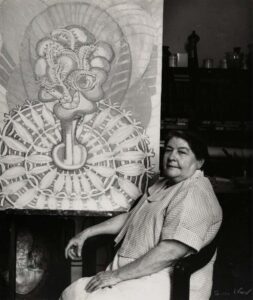Amelia Peláez

Peláez del Casal, Amelia, Yaguajay, Cuba (January 5, 1896 – Havana, April 8, 1968) She studied at the National School of San Alejandro, where she received influences from academic impressionism through the teacher Leopoldo Romañach Guillén. His influence on Peláez’s art can be seen in his painting Sailboats from 1925, which has a similar maritime theme to all of Romañach’s works and uses his palette and soft brushwork. In 1924, Peláez spent her break studying at the Arts Students League in New York with Professor Bridgman, which was a unique trip for her education, but that trip also left her largely dissatisfied with the limited styles of art to which that had been exposed. Taking matters into her own hands, she traveled to Paris in 1927 on a scholarship from her Alma Mater, as many of her classmates were doing. Accompanied by her fellow aspiring artist Lydia Cabrera, Peláez took classes around the city at the Académie de la Grande Chaumière, the École des Beaux-Arts, and the École du Louvre. After four years of studying French artistic styles, Peláez had not yet found her niche in painting and she enrolled at Fernand Léger’s Académie Moderne. Here she studied scene design and color dynamics with Alexandra Exter, a woman who had a great impact on Peláez’s art and life. Exter introduced Peláez to modernism, abstraction, and new and unique ways of expressing shapes and using color. Peláez also learned from Exter a sense of self and determination as a professional female artist.
In 1933, Peláez showed 33 works at the Galerie Zak, located on the Rue de l’Abbaye in Paris. The exhibition was very well received, and the following year she returned to Cuba following that success. As her artistic style developed, Peláez also spent periods of time working exclusively in one medium. She worked almost exclusively in pencil between 1935 and 36, another of these periods occurred in the early 1950s when she focused on ceramics. Her paintings of hers grew to have a more feminine and feminist focus when Peláez returned to Cuba . Her work completed at home is a demonstration of the development of her signature style with inspiration from fruit, architecture and traditional Cuban stained glass. Her perspective as a woman gave Peláez a special place in the world of the avant-garde because she was able to see life and Cuban tradition from a different perspective. She existed much more privately than her fellow avant-garde painters, and was only one of the few women who participated in the Latin American art movement.
Professional activity
1937
• Teacher. Free Study of Painting and Sculpture, Havana, Cuba
1949
• Founder member. Association of Painters and Sculptors of Cuba (APEC), Havana, Cuba.
1950
• Ceramist. Workshop of Dr. Rodríguez de la Cruz, Santiago de las Vegas, Havana, Cuba
1958
• Jury. I Inter-American Biennial of Painting and Engraving, National Museum of Plastic Arts, Mexico City, Mexico
1961
• Founder member. Union of Writers and Artists of Cuba (UNEAC), Havana, Cuba
Awards and distinctions
1935
• Prize. National Exhibition of Painting and Sculpture [College of Architects], Havana, Cuba.
1938
• Prize. II National Exhibition of Painting and Sculpture, Castillo de la Fuerza, Havana, Cuba.
1956
• Merit Award. VIII National Hall of Painting and Sculpture, Havana, Cuba.
1959
• Acquisition Award. Annual Salon 1959. Painting, Sculpture and Engraving, National Museum of Fine Arts, Havana, Cuba.
1962
• Acquisition Award. National Hall/1962. Tribute to Carlos Enríquez, National Museum of Fine Arts, Havana, Cuba.
1964
• Acquisition Award. National Hall of Painting and Sculpture 1964. Tribute to Fidelio Ponce de León, National Museum of Fine Arts, Havana, Cuba.
1968
• National Order “30 years Dedicated to Art”, Havana, Cuba.
1973
• Third Prize in Sculpture. Hall of Professors and Instructors of Plastic Arts, National Academy of Fine Arts – San Alejandro School, Havana, Cuba.
Exhibitions
1924: Amelia Peláez and María Pepa Lamarque. Association of Painters and Sculptors, Havana, Cuba.
1933: Galerie Zak, Paris, France.
1935: Lyceum, Havana, Cuba.
1936: Modern Painting Exhibition. Amelia Peláez, Carlos Enríquez and Ravenet, Circle of Friends of French Culture, Havana, Cuba.
1941: Norte Gallery, New York, United States.
1943: Retrospective. Hispanic Cuban Institute of Culture, Havana, Cuba.
1956: Our Time, Havana, Cuba.
1957: Lyceum, Havana, Cuba.
1959: Paintings by Amelia Peláez. Municipal Institute of Culture, Marianao, Havana, Cuba
1960: Amelia Peláez. Painting and Ceramics. Lyceum, Havana, Cuba.
1964: Oils and Tempera paintings by Amelia Peláez. Gallery of Havana, Cuba.
1967: Amelia Peláez. Gouaches, ceramics (February 7). Lyceum, Havana, Cuba.
1967: Drawings by Amelia Peláez. Museum of Modern Art, Bogotá, Colombia.
1968: Retrospective of Amelia Peláez. National Museum of Fine Arts, Havana, Cuba.
1971: Amelia Peláez Gallery, Lenin Park, Havana, Cuba.
1977: Metropolitan Museum and Art Center, Miami, Florida, United States.
1979: Museum of Modern Art, Mexico City, Mexico.
1980: Oils, tempera and ink. Museum of Modern Art, Bogotá, Colombia.
1981: Ceramics by Amelia Peláez. Museum of Decorative Arts, Havana, Cuba.
1985: Municipal Museum of October 10, Havana, Cuba.
1986: Anthological Exhibition. Paintings 1929 – 1967. Second Havana Biennial. National Museum of Fine Arts, Cuba.
1987: Sâo Paulo Biennial. Sao Paulo, Brazil.
1988: Retrospective. Cuban Museum of Art and Culture, Miami, Florida, United States and Museum of Modern Art of Latin America (OAS), Washington, D.C., United States.
1992: Retrospective Exhibition. Luis Ángel Arango Library, Bogotá, Colombia.
1996: Amelia Peláez del Casal. La Acacia Gallery, Havana, Cuba.
1997: Tarsila do Amaral/Frida Kahlo/Amelia Peláez. La Caixa Foundation, Madrid, Spain.
1998: L´empremta de Mallorca. “Sa Nostra” Culture Center, Palma de Mallorca, Spain and Amelia Peláez. Oil paintings, temperas and drawings. Gaya Nuño Cultural Center, Soria, Spain.
2000: The footprint of Mallorca. Cultural Center of Spain, Havana Cuba.